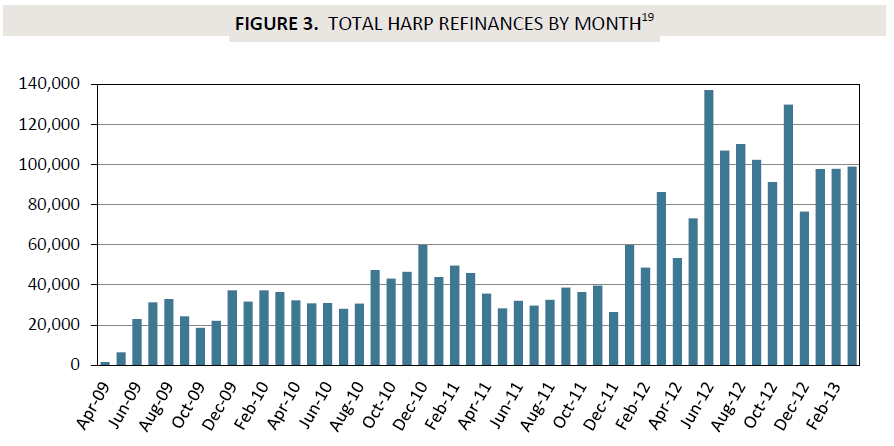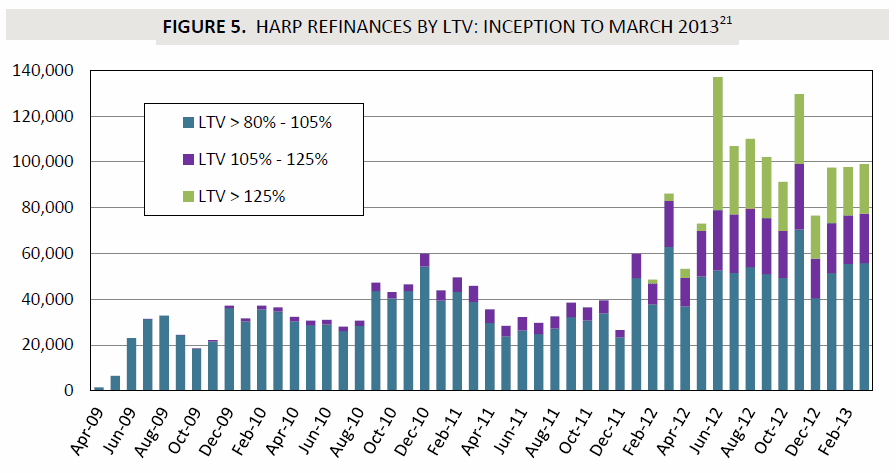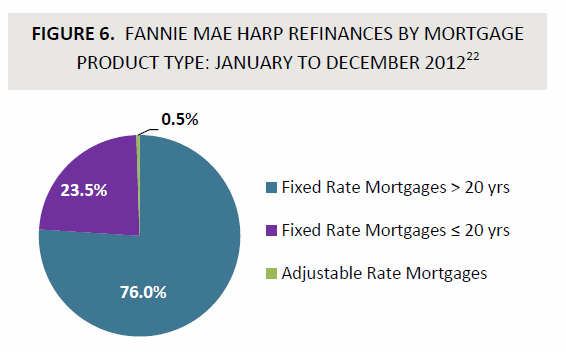Blog

Half-Time Report on HARP Largely Positive
ThernOffice of Inspector General (OIG) of the Federal Housing FinancernAgency (FHFA) has published an assessment of the Home AffordablernRefinance Program (HARP) at what is presumed to be the midpoint of itsrnexistence. HARP was designed to assist borrowers with existingrnmortgages owned or guaranteed by Freddie Mac or Fannie Mae (the GSEs)rnto refinance even where they had little or no equity, werernunderwater, in their homes.</p
HARPrnbegan in March 2009, a joint project of FHFA and the TreasuryrnDepartment. To qualify for the program under the guidelines for whatrnis now called HARP 1.0, a borrower had to be current on their monthlyrnmortgage payments and have a loan-to-value (LTV) ration of 105rnpercent or less (raised to 125 percent in the early days of thernprogram.) </p
WhenrnHARP 1.0 was announced it was anticipated that four to five million</bborrowers were eligible to refinance under the program, however byrnSeptember 2011 less than 1 million homeowners had done so. FHFA, thernGSEs, lenders, and other stakeholders identified several issues withrnthe program believed to be causing thernlackluster results:</p<ul<li
LoansrnwithrnLTVsrngreaterrnthanrn125%rnwerernnotrneligiblernforrnHARPrn1.0rnrefinances;</p</li<li<pThernshortrnprogramrndurationrnofrnapproximatelyrn15rnmonthsrndiscouragedrnlendersrnfromrninvestingrnresourcesrntornmarketrnandrnoriginaternHARPrnloans;</p</li<li<pRepresentationrnandrnwarrantyrnliabilityrndeterredrnlenderrnoriginations;</p</li<li<pManualrnpropertyrnappraisalsrnwerernrequiredrnforrnthernmajorityrnofrnoriginations;</p</li<li<pLendersrnwerernnotrnpermittedrntornsolicitrndirectlyrnHARP-eligiblernborrowersrnforrnrefinancing;rnand</p</li<li<pRisk-basedrnfeesrnincreasedrnup-frontrnborrowerrncostsrnandrndiminishedrnthernbenefitrnofrnarnlowerrninterestrnrate.</p</li</ul<pFHFArndirectedrnthernEnterprisesrntorncollaboraternwithrnstakeholdersrntornaddressrnthesernconcernsrnandrnimprovernthernprogram.rnAfterrnseveralrnmodificationsrnwerernagreedrnupon,rnFHFArnpubliclyrnannouncedrnthemrninrnOctoberrn2011,rnrebrandingrnthernprogramrnasrnHARPrn2.0.rn Changes included removing the 125 percent LTV ceiling, extending thernduration of HARP by 18 months, eliminating the requirement for arnmanual property appraisal, lowering the maximum amount of risk basedrnfees and revising lender solicitation guidelines, and allowingrnlenders to offer incentives to borrowers. Later modifications to thernprogram included substantial representation and warranty relief forrnlenders and reduced documentation requirements. FHFA also extendedrnHARP an additional two years, through December 31, 2015.</p<pAsrna result of the program modifications creating HARP 2.0 and thernsubsequent changes, refinance volume has substantially increased. Asrnof March 2013 2.4 million HARP refinances had been completed.</p
 </p
</p
OIGrnsaid that the savings realized by borrowers each month through thernHARP refinance is an important outcome. By lowering the monthlyrnpayment HARP reduces the risk of future default and potentiallyrnstimulates the economy. According to Fannie Mae’s 2012 data, HARPrnborrowers saved an average of $250 per month or $3,000 per year. </p<pAnotherrnoutcome is the effect HARP has had on high-LTV loans. As lendersrnbegan to implement the HARP 2.0 changes in early 2012, finance volumernfor loans with LTVs between 105 percent and 125 percent began tornincrease. Then in June 2012 the GSEs permitted lenders to includernHARP loans with LTVs greater than 125 percent into specialrnmortgage-backed securities (MBS) and refinance volume for these loansrndramatically increased.</p
 </p
</p
HARPrnwasrnalsorndesignedrntornplacernborrowersrninrnmorernstablernmortgagernand over 75 percent of HARP borrowers refinanced into fixed raternmortgages with terms greater than 20 years while less than 1 percentrnrefinanced into less stable adjustable rate mortgages. Further, arnsignificant percentage of borrowers chose to refinance into shorterrnterm mortgages which allow them to more quickly build equity in theirrnhomes.</p
 </p
</p
Anotherrnimportant dimension for HARP is the impact it has had on the GSEs. OIG looked at the financial impact on them as a function of fivernvariables, credit risk, guarantee fees, retained portfoliorninvestments, representation and warranty relief, and opportunityrncost. Some of these variables were found to be positive for thernGSEs finances, some negative or neutral. </p<pTherncredit risk associated with a HARP loan is intuitively lower thanrnthat of its original counterpart because the new mortgage has, atrnminimum, a lower interest rate, a lower payment, or a shorterrnamortization period than the original and may also have beenrnrefinanced into a more stable product. These conditions mean thernGSEs are likely to benefit from HARP.</p<pLikewise,rnguarantee fees are higher today than prior to 2009 and when arnpre-2009 loan is refinanced the GSEs are released from the earlierrng-fee structure and can securitize the refinanced loan and chargerntoday’s higher g-fee.</p<pHARPrnrefinances negatively impact the GSEs' retained portfolios because whenrnHARP eligible loans are refinanced (pre-paid) the GSEs no longerrnreceive interest payments on the original loan but purchase orrnguarantee a loan with a lower interest rates and thus less value. The effective cost to the GSEs is the difference in value from thernnet interest rate spread between the original loans and the newrnloans.</p<pTherncost of representation and warranty relief is neutral. The waiver ofrnsignificant representation and warranty protection mandated by HARPrn2.0 may negatively impact the GSEs, however the loans are seasonedrnloans made to borrowers with demonstrated ability to repay so thernactual cost of eliminating the representations and warranties isrnmitigated by the loan characteristics. </p<pOpportunityrncosts are foregone because there is no need for HARP eligiblernborrowers to acquire additional mortgage insurance or add equity torntheir loans. Thus because HARP exists, the GSEs forgo thernopportunity to reduce their credit risk through enhancements orrnrelieve themselves of the loan entirely. </p<pOIGrnfurther assessed HARP by looking at FHFA’s administration of thernprogram, analyzing performance data and program outcomes, andrnidentifying remaining program barriers. It found that FHFA’srnadministration of HARP had included its active engagement ofrnstakeholders to identify and address program problems includingrnmeeting with lenders, the GSEs, and mortgage insurers. To identifyrnissues confronting borrowers Fannie Mae conducted a comprehensivernsurvey of HARP-eligible borrowers in 2012 and the results of thisrnsurvey was shared with FHFA.</p<pThesernmeetings with stakeholders resulted in the identification andrnimplementation of a number of improvements such as the level ofrndocument required, aligning of same servicer and new lenderrnrequirements to enhance competition for borrower business, issuesrnwith representations and warranties, and aligning GSE requirements.</p<pOIGrnalso noted that FHFA had sought to increase HARP volume by pursuingrnstate-level support for the program – working with state housingrnfinance agencies that receive funds from the Treasury's Hardest HitrnFund.</p<pOIGrnfound that many of the barriers that earlier kept HARP from attainingrnits goals have been substantially mitigated but there are still somernissues remaining related to borrower knowledge and understanding ofrnthe program, origination and closing fees, lender placed mortgagerninsurance, and lender capacity constraints. To address the borrowerrnknowledge issues, FHFArnhas announced a nationwide public relations campaign to educaternborrowers about HARP. The campaign is specifically intended tornaddress the borrower misconceptions identified in the Fannie Maernborrower survey such as believing they are not eligible for thernprogram or that they have to use an unfamiliar lender.</p<pOIGrn concludes that, withrnoverrntwornyearsrnleftrninrnthernprogram,rnitrnisrndifficultrntornprojectrnhowrnmanyrnHARP-eligiblernloansrnultimatelyrnwillrnbernrefinancedrnbecause,rnamongrnotherrnfactors,rneducatingrnborrowersrnandrnencouragingrntheirrnparticipationrncontinuerntornbernmajorrnchallenges.
All Content Copyright © 2003 – 2009 Brown House Media, Inc. All Rights Reserved.nReproduction in any form without permission of MortgageNewsDaily.com is prohibited.
Latest Articles
By John Gittelsohn August 24, 2020, 4:00 AM PDT Some of the largest real estate investors are walking away from Read More...
Late-Stage Delinquencies are SurgingAug 21 2020, 11:59AM Like the report from Black Knight earlier today, the second quarter National Delinquency Survey from the Read More...
Published by the Federal Reserve Bank of San FranciscoIt was recently published by the Federal Reserve Bank of San Francisco, which is about as official as you can Read More...

Comments
Leave a Comment